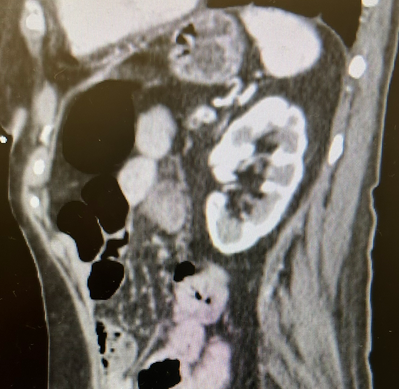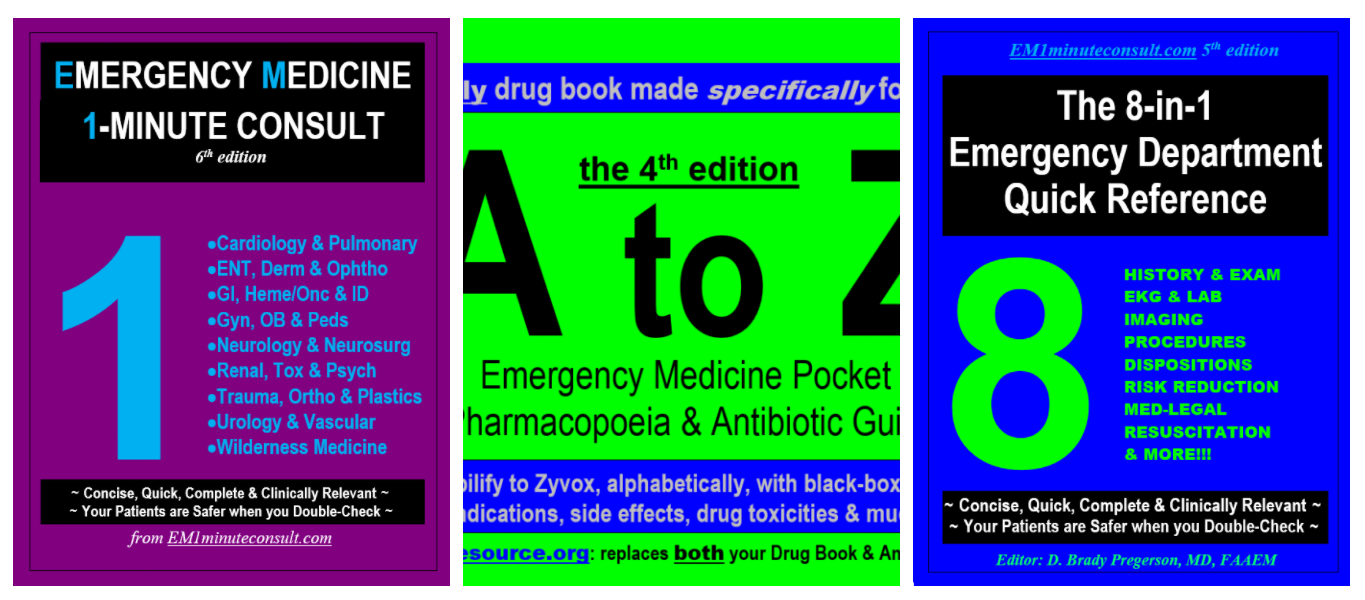History of Present Illness:
A female in her mid 80’s with a history of stroke and dementia is brought to the ED for 1 day of generalized abdominal pain. She has poor memory but doesn’t think she has vomiting. Her daughter is worried about bleeding because her stool was dark and she takes Eliquis.
Vital Signs & Physical Exam:
Vital signs are normal except for a pulse of 104. Physical exam is notable for rebound tenderness
Initial Diagnostic Testing:
- Labs: WBC 15, CO2 20, bili 1.8/0.9, lipase and other LFT’s normal except albumin 2.7
- Imaging: CXR normal. CT below

SCROLL DOWN FOR ANSWERS & 1-MINUTE CONSULT
What is the most likely diagnosis?
- A) Perforated viscus
- B) Mesenteric Ischemia
- C) SBO
- D) PUD with active bleed
<<<<<<<<<<<<<<<<<<<<< ADVERTISEMENT & SPACER >>>>>>>>>>>>>>>>>>>>>
THE EMERGENCY MEDICINE POCKETBOOK TRIFECTA

Emergency Medicine 1-Minute Consult, 5th edition
A-to-Z EM Pharmacopoeia & Antibiotic Guide, NEW 5th edition
8-in-1 Emergency Department Quick Reference, 5th edition
******************************************************************************
<<<<<<<<<<<<<<<<<<<<<<<<< END SPACER >>>>>>>>>>>>>>>>>>>>>>>>>
What is the most likely diagnosis?
- A) Perforated viscus
- B) Mesenteric Ischemia – CORRECT – there is a section of bowel that is not enhanced (just anterior to the lower pole of the kidney)
- C) SBO
- D) PUD with active bleed
CT read:
- THICK-WALLED LOOPS OF SMALL BOWEL IN LOWER ABDOMEN w/ DECREASED ENHANCEMENT SUSPICIOUS FOR BOWEL ISCHEMIA.
- PATENT PROXIMAL AND MID SMA. HOWEVER, THE DISTAL BRANCHES ARE NOT WELL OPACIFIED RAISING THE CONCERN FOR EMBOLISM/THROMBOSIS.
1-Minute Consult on this topic: Click HERE and scroll to proper page
CASE CONCLUSION: IR and G-surg consulted. Started on heparin and admitted to ICU for close observation. No intervention planned initially as occlusion was in the distal SMA with only a small area of intestine at risk. She was treated with antibiotics/heparin drip/IV hydration. Her overall status worsened. Her lactic acidosis worsened. Family then opted for comfort measures. Patient expired HD2. Daughter was at bedside. Patient was DNR/DNI with comfort measures at that time.
CASE LESSONS: Eliquis is most often for a-fib meaning you patient is not only at risk for bleeding but also for embolism to brain, heart, leg, intestines, kidney….
